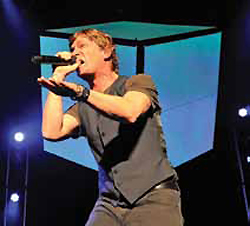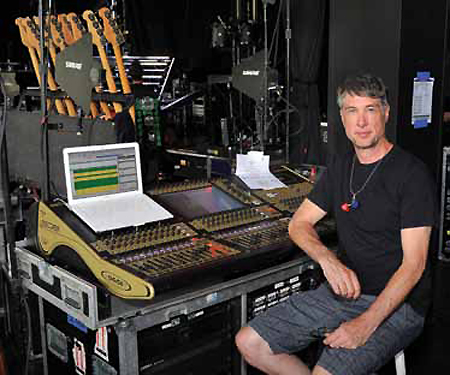
Maintaining a philosophy that simpler is better, Francis and the audio crew slightly shaved-back the number of inputs coming from the stage on this tour to 56. In a move based as much on sound quality as economics, DiGiCo SD8 consoles were chosen for use at both front of house and monitors.
“I was using a Profile and was happy with it,” Francis notes. “But then I tried a DiGiCo SD7 out at the behest of someone else and was really blown away by the sound. When I was told the price to rent one, I had to politely back away, as the band I was with at the time didn’t have that in their budget. Undaunted, the guy showing me the SD7 simply pulled the cover off of an SD8 sitting behind it. There was everything I needed plus the same sound, and it was affordable.”
Within the MB20 scheme, the two SD8s share the same stage rack and there is no splitter. The stage rack sits under the monitor board, and all the sub-snakes come off the stage and straight into the preamps at the rack. Francis controls the preamps from out front, while Lewis gain-tracks it. Therefore, if Francis makes a change, the system compensates automatically.
“We did the first leg of the tour with a Profile onstage,” he says, providing details of the show’s technical evolution. “There was a conventional splitter too, we did it like you’d normally do it. Well, I had done things differently, and suggested we could do things better. At one point we were considering sticking a MADI card into the Profile.
“We could’ve slaved off of that and it would’ve worked,” he continues, “but during the process Bob Lewis came out and looked at my DiGiCo. I did a quick demo, and he said ‘let’s change the whole console’ Within a single day after making the change we were up to speed.”
Working With It
Francis’ SD8 is a standard model. On this tour, all 12 of the console’s multiband compressors see constant use, as do several of the dynamic EQs, and onboard effects.
“I mix to groups,” he notes. “All the drums go into one group and there’s a standard bus compressor across that. I do use a multi-band on the kick drum, and almost everything is gated. But gated pretty loosely because of the lack of stage volume. Given the dynamics of this show, there are a lot of songs in which the gates are just off.”
For Rob Thomas’ lead vocals, Francis uses the console’s onboard de-esser. Thomas, whose natural voice has a pronounced sibilance, started out the tour with a Telefunken M80, a mic which was also spread across every other vocal position.
“I couldn’t get the sibilance in his voice to sound natural with that mic,” Francis says. “It has a 6-8K bump that makes most vocals sound phenomenal and airy, but it just didn’t work for him. We changed to the new Shure KSM9HS. Rob has a well-rounded voice, and this is a really fat mic that works well with it. The contrast we gained between Rob and the backing vocals is awesome as well.”


